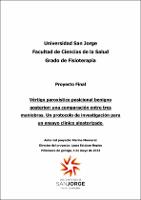Por favor, use este identificador para citar o enlazar este ítem:
https://repositorio.usj.es/handle/123456789/944
Registro completo de metadatos
| Campo DC | Valor | Lengua/Idioma |
|---|---|---|
| dc.contributor.advisor | Esteban-Repiso, Laura | - |
| dc.contributor.author | Monneret, Marine | - |
| dc.date.accessioned | 2023-07-20T11:20:25Z | - |
| dc.date.available | 2023-07-20T11:20:25Z | - |
| dc.date.issued | 2023-05 | - |
| dc.date.submitted | 2023-05 | - |
| dc.identifier.uri | https://repositorio.usj.es/handle/123456789/944 | - |
| dc.description | The posterior benign paroxysmal positional vertigo is a pathology very frequent that affects the vestibular system, with a high incidence and recurrence rate. There exists different treatment for this pathology, and the ones with higher evidence are the repositioning maneuvers. Epley, Semont and Gans maneuvers are the most common to treat the P-BPPV. The protocol’s objective is to investigate in all three maneuvers and determine which one is the more effective for the treatment of P-BPPV, to increase the quality of life, global efficiency, and lower recurrence. It consists in a randomized clinical trial, with 30 patients diagnosed with P-BPPV, and split into three groups, one for each maneuver. The analyzed variables are the quality of life, using the DHI, the efficacy of the maneuvers with the discomfort and pain provoked, as the numbers of repetition needed and the recurrence rate. Within this protocol, it is expected to observe an improvement of symptoms in the three groups, and it is also expected to find a difference between them, which could influence the choice of the appropriate maneuver according to the profile and needs of the patient. Therefore, the development of this protocol will allow a better understanding of the side effects of the treatments with repositioning maneuvers, exploring variables that are not very present in the current literature. | en_US |
| dc.description.abstract | El vértigo paroxístico posicional benigno posterior es una patología muy frecuente del aparato vestibular, con una incidencia y una tasa de recurrencia alta. Existe diferentes tratamientos para esta patología, y los tratamientos con la mejor evidencia clínica son las maniobras de recolocación. Para esta patología, la maniobra de Epley, de Semont y de Gans son las más comunes. El objetivo de este protocolo es de identificar cuál de estas tres maniobras será la más eficaz en el tratamiento de VPPB-P, que sea para la calidad de vida, la eficacia general, y el impacto positivo en la recurrencia. Se tratará de un ensayo clínico aleatorizado con 30 pacientes diagnosticados con un VPPB-P, y divididos en tres grupos, uno para cada maniobra. Las variables analizadas serán la calidad de vida con la DHI, la eficacia de las maniobras con la molestia y el dolor provocado, el número de repeticiones, así que la recurrencia de la patología. Dentro de este protocolo se esperará observar una mejora de los síntomas en los tres grupos, y también se espera encontrar a una diferencia entre ellas, que podría influir en la elección de la maniobra adecuada según el perfil y las necesidades del paciente. Entonces el desarrollo de este protocolo permitirá entender mejor los efectos segundarios a los tratamientos con las maniobras de recolocación, explorando variables no muy presentes en la literatura actual. | en_US |
| dc.format.extent | 30 p. | en_US |
| dc.format.mimetype | application/pdf | en_US |
| dc.language.iso | spa | en_US |
| dc.relation.requires | Adobe pdf | en_US |
| dc.rights | Attribution-NonCommercial-NoDerivatives 4.0 Internacional | * |
| dc.rights.uri | http://creativecommons.org/licenses/by-nc-nd/4.0/ | * |
| dc.subject | Vértigo periférico | en_US |
| dc.subject | Vértigo paroxístico posicional benigno | en_US |
| dc.subject | VPPB | en_US |
| dc.subject | Maniobra de Epley | en_US |
| dc.subject | Maniobra de Semont | en_US |
| dc.subject | Maniobra de Gans | en_US |
| dc.subject | Calidad de vida | en_US |
| dc.subject | Dolor | en_US |
| dc.subject | Recurrencia | en_US |
| dc.subject | Peripheral vertigo | en_US |
| dc.subject | Benign Paroxysmal Positional Vertigo | en_US |
| dc.subject | BPPV | en_US |
| dc.subject | Epley’s maneuver | en_US |
| dc.subject | Semont’s maneuver | en_US |
| dc.subject | Gans’s maneuver | en_US |
| dc.subject | Quality of life, Pain, Recurrence | en_US |
| dc.title | Vértigo paroxístico posicional benigno posterior: una comparación entre tres maniobras. Un protocolo de investigación para un ensayo clínico aleatorizado | en_US |
| dc.type | info:eu-repo/semantics/bachelorThesis | en_US |
| dc.rights.accessrights | info:eu-repo/semantics/openAccess | en_US |
| dc.contributor.affiliation | Universidad San Jorge | en_US |
| Aparece en las colecciones: | Grado en Fisioterapia | |
Ficheros en este ítem:
| Fichero | Descripción | Tamaño | Formato | |
|---|---|---|---|---|
| Vértigo paroxístico posicional benigno posterior.pdf | 899,85 kB | Adobe PDF |  Visualizar/Abrir |
Este ítem está sujeto a una licencia Creative Commons Licencia Creative Commons

